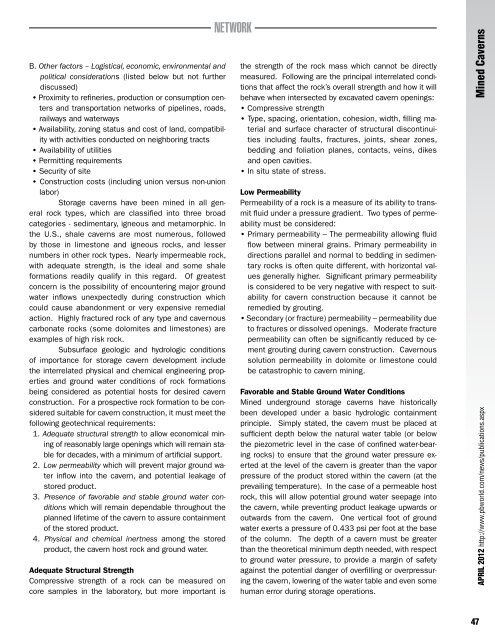Mining & Mined Caverns - Parsons Brinckerhoff
Mining & Mined Caverns - Parsons Brinckerhoff
Mining & Mined Caverns - Parsons Brinckerhoff
Create successful ePaper yourself
Turn your PDF publications into a flip-book with our unique Google optimized e-Paper software.
B. Other factors – Logistical, economic, environmental and<br />
political considerations (listed below but not further<br />
discussed)<br />
• Proximity to refineries, production or consumption centers<br />
and transportation networks of pipelines, roads,<br />
railways and waterways<br />
• Availability, zoning status and cost of land, compatibility<br />
with activities conducted on neighboring tracts<br />
• Availability of utilities<br />
• Permitting requirements<br />
• Security of site<br />
• Construction costs (including union versus non-union<br />
labor)<br />
Storage caverns have been mined in all general<br />
rock types, which are classified into three broad<br />
categories - sedimentary, igneous and metamorphic. In<br />
the U.S., shale caverns are most numerous, followed<br />
by those in limestone and igneous rocks, and lesser<br />
numbers in other rock types. Nearly impermeable rock,<br />
with adequate strength, is the ideal and some shale<br />
formations readily qualify in this regard. Of greatest<br />
concern is the possibility of encountering major ground<br />
water inflows unexpectedly during construction which<br />
could cause abandonment or very expensive remedial<br />
action. Highly fractured rock of any type and cavernous<br />
carbonate rocks (some dolomites and limestones) are<br />
examples of high risk rock.<br />
Subsurface geologic and hydrologic conditions<br />
of importance for storage cavern development include<br />
the interrelated physical and chemical engineering properties<br />
and ground water conditions of rock formations<br />
being considered as potential hosts for desired cavern<br />
construction. For a prospective rock formation to be considered<br />
suitable for cavern construction, it must meet the<br />
following geotechnical requirements:<br />
1. Adequate structural strength to allow economical mining<br />
of reasonably large openings which will remain stable<br />
for decades, with a minimum of artificial support.<br />
2. Low permeability which will prevent major ground water<br />
inflow into the cavern, and potential leakage of<br />
stored product.<br />
3. Presence of favorable and stable ground water conditions<br />
which will remain dependable throughout the<br />
planned lifetime of the cavern to assure containment<br />
of the stored product.<br />
4. Physical and chemical inertness among the stored<br />
product, the cavern host rock and ground water.<br />
Adequate Structural Strength<br />
Compressive strength of a rock can be measured on<br />
core samples in the laboratory, but more important is<br />
Network<br />
the strength of the rock mass which cannot be directly<br />
measured. Following are the principal interrelated conditions<br />
that affect the rock’s overall strength and how it will<br />
behave when intersected by excavated cavern openings:<br />
• Compressive strength<br />
• Type, spacing, orientation, cohesion, width, filling material<br />
and surface character of structural discontinuities<br />
including faults, fractures, joints, shear zones,<br />
bedding and foliation planes, contacts, veins, dikes<br />
and open cavities.<br />
• In situ state of stress.<br />
Low Permeability<br />
Permeability of a rock is a measure of its ability to transmit<br />
fluid under a pressure gradient. Two types of permeability<br />
must be considered:<br />
• Primary permeability – The permeability allowing fluid<br />
flow between mineral grains. Primary permeability in<br />
directions parallel and normal to bedding in sedimentary<br />
rocks is often quite different, with horizontal values<br />
generally higher. Significant primary permeability<br />
is considered to be very negative with respect to suitability<br />
for cavern construction because it cannot be<br />
remedied by grouting.<br />
• Secondary (or fracture) permeability – permeability due<br />
to fractures or dissolved openings. Moderate fracture<br />
permeability can often be significantly reduced by cement<br />
grouting during cavern construction. Cavernous<br />
solution permeability in dolomite or limestone could<br />
be catastrophic to cavern mining.<br />
Favorable and Stable Ground Water Conditions<br />
<strong>Mined</strong> underground storage caverns have historically<br />
been developed under a basic hydrologic containment<br />
principle. Simply stated, the cavern must be placed at<br />
sufficient depth below the natural water table (or below<br />
the piezometric level in the case of confined water-bearing<br />
rocks) to ensure that the ground water pressure exerted<br />
at the level of the cavern is greater than the vapor<br />
pressure of the product stored within the cavern (at the<br />
prevailing temperature). In the case of a permeable host<br />
rock, this will allow potential ground water seepage into<br />
the cavern, while preventing product leakage upwards or<br />
outwards from the cavern. One vertical foot of ground<br />
water exerts a pressure of 0.433 psi per foot at the base<br />
of the column. The depth of a cavern must be greater<br />
than the theoretical minimum depth needed, with respect<br />
to ground water pressure, to provide a margin of safety<br />
against the potential danger of overfilling or overpressuring<br />
the cavern, lowering of the water table and even some<br />
human error during storage operations.<br />
<strong>Mined</strong> <strong>Caverns</strong><br />
APRIL 2012 http://www.pbworld.com/news/publications.aspx<br />
47

















